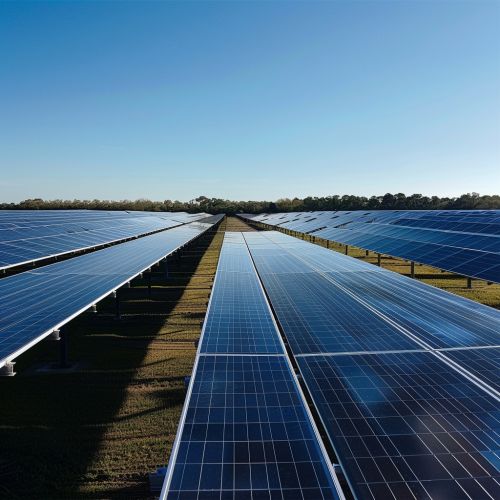Renewable Energy Transition
Introduction
The renewable energy transition refers to the global shift from fossil fuel-based energy systems to renewable energy sources such as solar, wind, hydroelectric, biomass, and geothermal. This transition is driven by the need to mitigate climate change, reduce greenhouse gas emissions, and achieve sustainable energy systems. It involves technological advancements, policy changes, economic considerations, and social transformations.
Historical Context
The concept of renewable energy is not new. Historically, humans have utilized renewable resources for millennia, such as wind for sailing ships and water for milling grain. However, the industrial revolution marked a significant shift towards fossil fuels like coal, oil, and natural gas due to their high energy density and ease of transport and storage.
The modern renewable energy transition began in the mid-20th century, spurred by the oil crises of the 1970s, which highlighted the vulnerabilities of fossil fuel dependence. The environmental movement of the 1960s and 1970s also played a crucial role, raising awareness of the ecological impacts of fossil fuel consumption.
Technological Advancements
Solar Power
Solar power harnesses energy from the sun using photovoltaic cells or solar thermal systems. Photovoltaic cells convert sunlight directly into electricity, while solar thermal systems use mirrors or lenses to concentrate sunlight and generate heat, which can then be used to produce electricity.


Recent advancements in solar technology include the development of more efficient photovoltaic materials, such as perovskite solar cells, and innovations in solar panel design, such as bifacial panels that capture sunlight from both sides.
Wind Power
Wind power converts kinetic energy from wind into mechanical energy using wind turbines. Modern wind turbines are highly efficient and can be deployed onshore or offshore. Offshore wind farms, in particular, have gained popularity due to their higher and more consistent wind speeds.
Technological improvements in wind power include larger turbine blades, advanced materials, and better control systems, which have significantly increased the capacity and efficiency of wind turbines.
Hydropower
Hydropower generates electricity by harnessing the energy of flowing water. It is one of the oldest and most established forms of renewable energy. Large-scale hydropower projects, such as dams, have been the primary source of hydropower, but there is growing interest in small-scale and run-of-the-river projects that have less environmental impact.
Advancements in hydropower technology include more efficient turbines, better fish-friendly designs, and innovations in pumped-storage hydropower, which can store excess energy for later use.
Biomass
Biomass energy is derived from organic materials such as wood, agricultural residues, and animal waste. It can be used for heating, electricity generation, and as a feedstock for biofuels. Biomass is considered renewable as long as the rate of consumption does not exceed the rate of regeneration.
Technological advancements in biomass energy include improved combustion technologies, more efficient conversion processes, and the development of advanced biofuels like cellulosic ethanol and biodiesel.
Geothermal Energy
Geothermal energy harnesses heat from the Earth's interior to generate electricity or provide direct heating. It is a reliable and consistent energy source, particularly in regions with significant geothermal activity.
Recent advancements in geothermal technology include enhanced geothermal systems (EGS), which can extract heat from dry rock formations, and the use of binary cycle power plants that can operate at lower temperatures.
Policy and Regulatory Frameworks
The renewable energy transition is heavily influenced by policy and regulatory frameworks at the local, national, and international levels. Governments play a crucial role in promoting renewable energy through subsidies, tax incentives, feed-in tariffs, and renewable portfolio standards.
International agreements, such as the Paris Agreement, aim to limit global warming by reducing greenhouse gas emissions and increasing the share of renewable energy in the global energy mix. National policies vary widely, with some countries leading the way in renewable energy adoption, while others lag behind.
Economic Considerations
The economics of renewable energy have improved dramatically in recent years. The cost of solar and wind power has decreased significantly, making them competitive with, or even cheaper than, fossil fuels in many regions. Economies of scale, technological advancements, and increased investment have all contributed to this trend.
However, the transition to renewable energy also involves significant upfront costs for infrastructure development, grid integration, and energy storage solutions. Financing mechanisms, such as green bonds and public-private partnerships, are essential to support these investments.
Social and Environmental Impacts
The renewable energy transition has profound social and environmental impacts. On the positive side, it can reduce air pollution, decrease greenhouse gas emissions, and create new jobs in the renewable energy sector. However, it also poses challenges, such as the displacement of communities for large-scale projects, the environmental impact of mining for renewable energy materials, and the need for a just transition for workers in the fossil fuel industry.
Challenges and Barriers
Despite the progress made, several challenges and barriers hinder the renewable energy transition. These include:
- **Intermittency**: Solar and wind power are intermittent energy sources, requiring advanced energy storage solutions and grid management to ensure a reliable supply.
- **Infrastructure**: Upgrading and expanding the energy grid to accommodate decentralized renewable energy sources is a significant challenge.
- **Policy and Regulation**: Inconsistent policies and regulatory frameworks can create uncertainty and hinder investment in renewable energy.
- **Public Acceptance**: Social acceptance of renewable energy projects, particularly large-scale installations, can be a barrier due to concerns about visual impact, noise, and land use.
Future Prospects
The future of the renewable energy transition looks promising, with continued advancements in technology, policy support, and growing public awareness of the need for sustainable energy systems. Innovations in energy storage, smart grids, and digitalization are expected to play a crucial role in overcoming current challenges and accelerating the transition.
Conclusion
The renewable energy transition is a complex and multifaceted process that requires coordinated efforts from governments, industry, and society. While significant progress has been made, much work remains to be done to achieve a sustainable and resilient energy system. The continued development and deployment of renewable energy technologies, supportive policies, and public engagement are essential to realizing the full potential of renewable energy.
